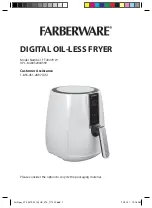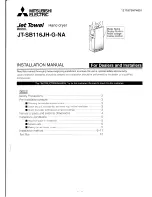
14
Tips and tricks
Tips for deep frying oil or fat
▯
Only use pure plant oil or fat that can be heated
up hot and is suitable for deep frying. Suitable
substances include peanut, palm or coconut oil.
Unsuitable substances include virgin olive oil, soy
or wheat germ oil. Avoid mixing different types.
Observe the manufacturer specifications.
▯
After each time deep frying, remove potentially
remaining large chunks from the deep-frying oil or
fat using a perforated spoon. You can also drain
the residue using the oil drain valve. Wait until the
deep frying oil or fat has cooled down to a
maximum of 100 °F (45 °C).
▯
If you wish to reuse the deep-frying oil or fat, line
a metal strainer with a paper towel and pour the
lukewarm oil or fat through it.
▯
Replace the deep-frying oil or fat once it smells or
tastes unpleasant, foams heavily or begins
smoking early on (at 320 - 340 °F/160 - 170 °C),
or if the food no longer becomes crispy, although
the temperature is set correctly. Rising steam
from damp food shouldn't be confused with early
smoking.
▯
Put on the lid once it has cooled down. This
prevents contaminants or water from getting into
the fat.
Tips for deep frying food
▯
The following foods are suitable for deep frying:
small pieces of meat or fish, vegetables, potatoes,
pasta, fruit, breaded food.
▯
Always thoroughly dry off damp food, such as
fish, shellfish, pieces of meat, and vegetable or
fruit peels.
▯
Foods containing large amounts of water are not
suitable for deep frying.
Tips for deep frying
▯
Don't deep fry too large of quantities at once so
that the oil can circulate well and quickly transfer
heat to the food. Shake the food around so that it
doesn't stick to each other and the oil can
circulate better.
▯
The food should be completely immersed in deep
frying oil or fat. Otherwise it must be turned
halfway through the frying time or pushed down
with another frying basket.
▯
Fill the frying basket on a countertop next to the
deep fryer, not in or over the deep fryer. This
keeps the deep frying oil or fat free of residue for
longer.
▯
Don't salt or season over the deep fryer, in order
to prevent contaminating the deep frying oil or fat.
▯
Inserting damp or frozen food causes the deep
frying oil or fat to foam particularly heavily. Lower
the frying basket slowly several times. This
prevents the fat from running over.
▯
With frozen foods, remove the ice prior to deep
frying.
▯
Set the recommended temperature.
‒
Correct temperature: Proteins form a
protective crust. This prevents much fat from
penetrating.
‒
Too high of temperature: The surface of the
food becomes encrusted too quickly The
insides remain raw.
‒
Too low of temperature: The food absorbs too
much fat.
▯
Dab off freshly deep-fried food with a paper
towel. This further reduces the amount of fat.
Summary of Contents for VF 230 614
Page 1: ......
Page 2: ......
Page 3: ......
Page 4: ......
Page 5: ......
Page 6: ......
Page 7: ......
Page 8: ......
Page 9: ......
Page 10: ......
Page 11: ......
Page 12: ......
Page 13: ......
Page 14: ......
Page 15: ......
Page 16: ......
Page 17: ......
Page 18: ......
Page 19: ......
Page 20: ......
Page 21: ......
Page 22: ......
Page 23: ......
Page 24: ......
Page 25: ......
Page 26: ......
Page 27: ......
Page 28: ......
Page 29: ......
Page 30: ......
Page 31: ......
Page 32: ......
Page 33: ......
Page 34: ......
Page 35: ......
Page 36: ......
Page 37: ......
Page 38: ......
Page 39: ......
Page 40: ......
Page 41: ......
Page 42: ......
Page 43: ......
Page 44: ......
Page 45: ......
Page 46: ......
Page 47: ......
Page 48: ......
Page 49: ......
Page 50: ......
Page 51: ......
Page 52: ......















































